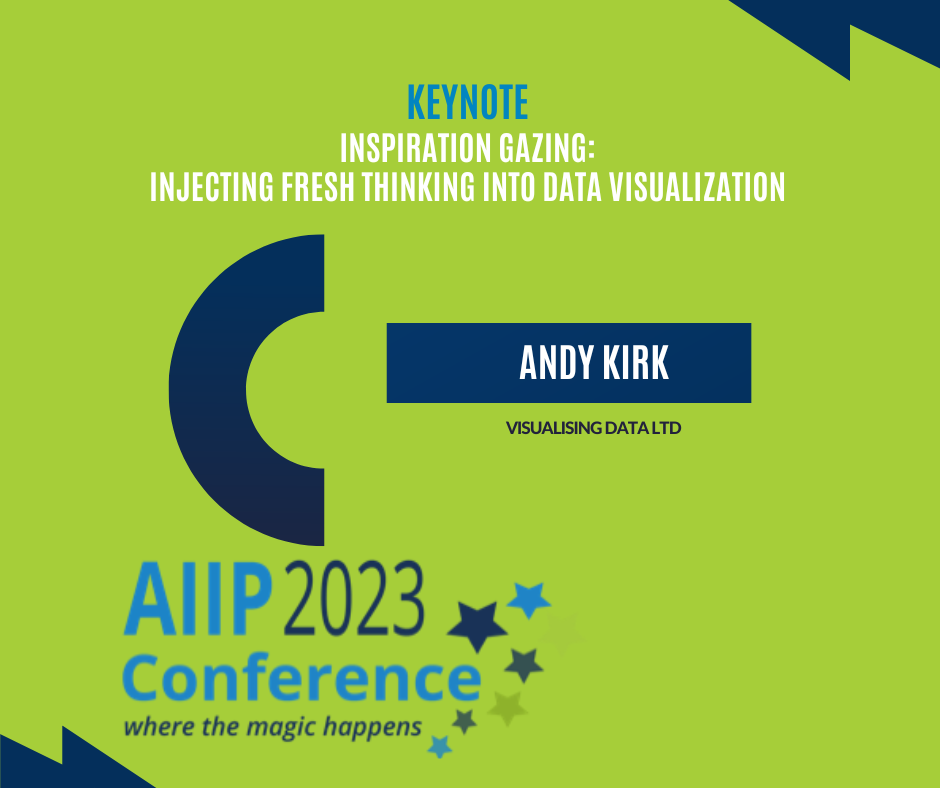Inspiration-gazing, Fresh Thinking, and Data Visualization

The ability to tell stories using data in a visually compelling way can be a strategic and effective component of the infopreneur toolbox – we want to help our clients understand the stories data tell. Looking at data visualization differently, and growing that part of the toolbox, was the focus of a thought-provoking keynote presentation at the AIIP23 Conference in April by data visualization expert Andy Kirk.
Andy is a UK-based design consultant, trainer, and author. He writes, teaches, and promotes the topic through public speaking and his podcast Explore Explain. He showed conference attendees his unique process for data visualization – “dataviz” in his parlance – and explained how he finds innovative ways to make complex data sets engaging.

Andy Kirk
What is inspiration-gazing?
Andy focused on the complementary nature of inspiration – where he finds it – and gazing or observation, including being alert to what activates creative stimulation. Together, they make for “inspiration-gazing” – opening your eyes to things that inspire and help you make complex data and concepts interesting and easy to understand for your clients.
He finds inspiration in objects or circumstances that stimulate the creative side of his mind. These are things that spark awe, desire, aspiration, delight, excitement, and enthusiasm. Andy shared some of his favorite sources – from boat and car designs to expensive wristwatches and mid-century modern furniture. Modest things inspire him, too, like the beauty of his apple peeler/corer.
Where can you look for inspiration?
Andy encouraged us to be more aware of what inspires us and why, and to look for innovative approaches we can bring into our own dataviz. Assuming inspiration has a positive effect on our thinking, he asked us to think about what we gaze at that helps stimulate our creative thinking.
So, what inspires Andy Kirk? He finds inspiration in:
Arts and crafts – fine and modern art, sculpture, illustration, satire
Graphic design – posters, covers, branding, signage, typography
Photography – inspiring moments, scale, movement
Moviemaking – camera effects, composition, storyboards
Game design – puzzles, board games, video games
Architecture and nature – buildings, planning, textures, scale, forms
It may not just be beautiful or well-designed things that inspire. Andy pushed a contrarian perspective, too.
For example, mundane things can be inspirational – they may inspire people to do things differently. Reading poorly written books might help you become a better writer. Dataviz that doesn’t actually explain things well might teach you how to present data to clients or peers effectively. What he called the “art of nothingness” plays a part, also – what we can’t do can sometimes help us do something else.
What makes a dataviz chart effective?
Andy used classic and innovative examples to highlight his three principles for evaluating dataviz:
Trustworthiness – how does the dataviz relate to the sources used, the data, and the creator?
Accessibility – are there clear instructions for “reading” the illustration?; how do the topics, colors, and size relate to each other?; does it take the right amount of time to understand it?
Elegance – is it beautiful or attractive? Does it appeal enough for you to stick around?
In the Q&A portion of his keynote, Andy answered questions about training and dataviz tools. He (humbly) said if he can do it, anyone can do it and recommended exploring abundant training options, from books and websites to podcasts and courses. Open-source tools for dataviz such as RawGraphs.io can also be a good resource.
Andy’s final takeaway: being a better, smarter consumer of dataviz is a precursor to creating it. Utilizing what inspires you is the key for Andy Kirk.
Chris Cochran is principal of Cochran Information Services and helps his clients solve their information puzzles. He serves as editor of the AIIP Connections Blog.





